
Carcharhiniformes, the ground sharks, are the largest order of sharks, with over 270 species. They include a number of common types, such as catsharks, swellsharks, and the sandbar shark.
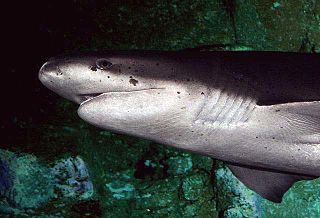
The Hexanchiformes are a primitive order of sharks, that numbering just seven extant species in two families. Fossil sharks that were apparently very similar to modern sevengill species are known from Jurassic specimens.
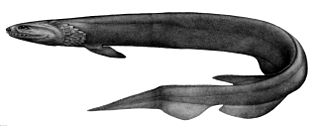
The frilled shark, also known as the lizard shark, is one of the two extant species of shark in the family Chlamydoselachidae. The frilled shark is considered a living fossil, because of its primitive, anguilliform (eel-like) physical traits, such as a dark-brown color, amphistyly, and a 2.0 m (6.6 ft)–long body, which has dorsal, pelvic, and anal fins located towards the tail. The common name, frilled shark, derives from the fringed appearance of the six pairs of gill slits at the shark's throat.

The Lamniformes are an order of sharks commonly known as mackerel sharks. It includes some of the most familiar species of sharks, such as the great white, as well as more unusual representatives, such as the goblin shark and megamouth shark.
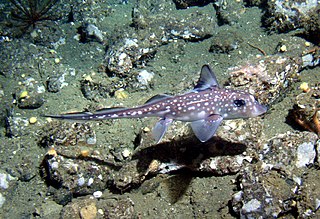
Chimaeras are cartilaginous fish in the order Chimaeriformes, known informally as ghost sharks, rat fish, spookfish, or rabbit fish; the last three names are not to be confused with rattails, Opisthoproctidae, or Siganidae, respectively.
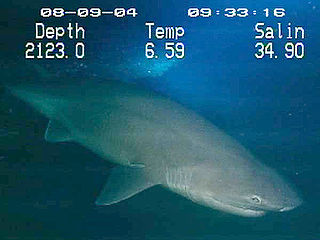
Cow sharks are a shark family, the Hexanchidae, characterized by an additional pair or pairs of gill slits. Its 37 species are placed within the 10 genera: Gladioserratus, Heptranchias, Hexanchus, Notidanodon, Notorynchus, Pachyhexanchus, Paraheptranchias, Pseudonotidanus, Welcommia, and Weltonia.

Chlamydoselachus is a genus of sharks and the sole extant member of the family Chlamydoselachidae, in the order Hexanchiformes. It contains two extant and four extinct species. The most widely known species still surviving is the frilled shark. It is known as a living fossil, along with Chlamydoselachus africana, also known as the southern African frilled shark, which is only found along coastal areas of South Africa. The only two extant species of this genus are deep-sea creatures which are typically weakened in areas closer to the surface. While the two extant species are similar in external appearance, they differ internally.
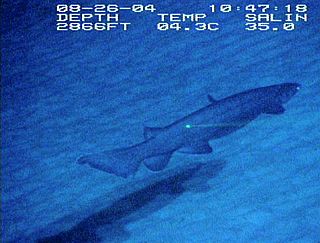
The southern African frilled shark is a species of shark in the family Chlamydoselachidae, described in 2009. It is found in the deep waters off southern Angola to southern Namibia. This species is difficult to distinguish from the better-known frilled shark, but is smaller at maturity and differs in several proportional measurements including head length and mouth width. It seems to be a specialized predator of smaller sharks, using its flexible jaws and numerous needle-like, recurved teeth to capture and swallow them whole. Reproduction is presumably aplacental viviparous, as with the other member of its family.
The shark order Hexanchiformes is often considered the most primitive of extant sharks, since they share some features with Paleozoic and early-Mesozoic shark groups as the Cladoselachiformes. Thus, it is interesting to see how far back the fossil record of this order reaches.
The Northumberland Formation is a Late Cretaceous (?Campanian-?Maastrichtian)-aged geologic formation in Canada. It belongs to the larger Nanaimo Group. Indeterminate bird and pterosaur fossils have been recovered from the formation, as well as a potential gladius of Eromangateuthis. An extensive diversity of shark teeth is known from the formation; many appear to be closely allied with modern deep-water shark taxa, suggesting a deep-water environment for the formation. The most well-known exposures of the formation are on Hornby Island.
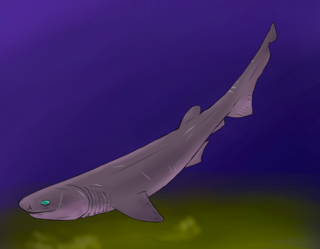
Mcmurdodus is an extinct genus of chondrichthyan from Antarctica and Australia and the sole member of the family Mcmurdodontidae. It contains two extinct species. However, the Australian species M. whitei has been found to be different from the Antarctic type species M. featherensis, and thus M. whitei has been classified into a new genus, Maiseyodus.
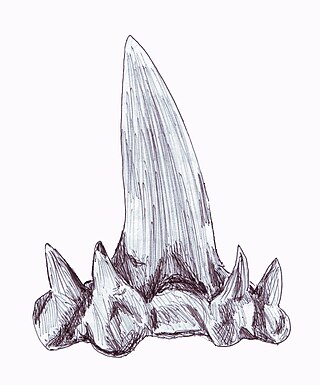
Cladodont is the term for a common category of early Devonian shark known primarily for its "multi-cusped" tooth consisting of one long blade surrounded by many short, fork-like tines, designed to catch food that was swallowed whole, instead of being used to saw off chunks of meat like many modern sharks. The skinny teeth would puncture and grasp the prey, keeping it from wriggling free.
Chlamydoselachus garmani is an extinct species of large frilled shark from the Miocene. Fossils have been found in Germany.
Notidanodon is an extinct genus of cow shark. Fossils ascribed to this genus are known from the Jurassic and Cretaceous periods. Recently, the genus underwent a major revision and was split into two after the erection of Xampylodon to accommodate the species X. dentatus, X. loozi, and X. brotzeni. The genus is now known only from New Zealand, Antarctica, Africa, and South America.

Ctenacanthiformes is an extinct order of elasmobranch fish. They possessed ornamented fin spines at the front of their dorsal fins and cladodont-type dentition, that is typically of a grasping morphology, though some taxa developed cutting and gouging tooth morphologies. Some ctenacanths are thought to have reached sizes comparable to the great white shark, with body lengths of up to 7 metres (23 ft) and weights of 1,500–2,500 kilograms (3,300–5,500 lb). Ctenacanths are typically thought to have existed from the Devonian to the Late Permian, becoming extinct in the Permian-Triassic extinction event. Members of the family Ctenacanthidae may have survived into the Cretaceous based on teeth found in deep water deposits of Valanginian age in France and Austria, however, other authors contend that the similarity of these teeth to Paleozoic ctenacanths is only superficial, and they likely belong to neoselachians instead. The monophyly of the group has been questioned, with some studies recovering the group as a whole as paraphyletic or polyphyletic.
Hessinodon is an extinct genus of possible kitefin sharks that lived during the Late Cretaceous. It contains one valid species, H. wardi, which is known from four teeth from the Northumberland Formation of British Columbia. Its teeth are most similar to those of modern cookiecutter sharks.
Rolfodon is an extinct genus of shark in the family Chlamydoselachidae. It is closely related to the extant frilled sharks in the genus Chlamydoselachus, which it can be differentiated from by tooth morphology. It is named after late Canadian paleontologist Rolf Ludvigsen.
Dykeius is an extinct genus of large shark in the family Chlamydoselachidae. It contains a single known species, D. garethi, from the Late Cretaceous Northumberland Formation of Canada. The genus and species names honor paleontologist Gareth J. Dyke.
Komoksodon is an extinct genus of hexanchiform shark known from the Late Cretaceous to the Paleocene. It is the only member of the monotypic family Komoksodontidae.
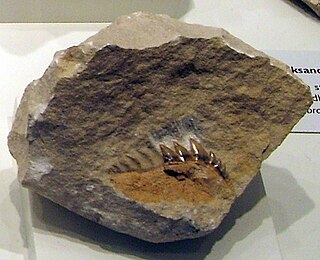
Xampylodon is an extinct genus of cow shark. Fossils assigned to this genus are known from the Late Cretaceous and early Paleocene. Xampylodon was recently erected after a revision on the taxonomy of hexanchid fossil teeth, and includes three species previously included in Notidanodon.












